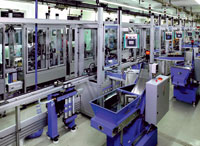
Posted to News on 30th Jan 2014, 00:00
Bronze skies and Industry 4.0
Industry 4.0 is a new concept which has been gaining significant momentum across Europe. GAMBICA's Deputy Director and convener of the organisation's Variable Speed Drives group, Steve Brambley, explains how it applies to the automation industry.

>A little known fact about the ancient Greeks is that they didn't have a word for the colour blue. Because of this, the poet Homer described the sky as bronze in his writings. This is typical of the way language develops - the name we give something is coined after the thing itself comes into existence or is observed. However, Industry 4.0 didn't follow the normal etymological route; the phrase was introduced at the Hanover fair in 2011 to describe a new trend towards the networking of traditional industries such as manufacturing.
>Industry 4.0 is closely related to other industry concepts such as Machine-to-Machine communication (M2M), the Internet of Things (IoT) and Cyber-physical Systems (CPS). The name Industry 4.0 recognises the existence of three previous industrial revolutions. The first was the mechanisation of manufacturing using steam power; the second was the introduction of electric power and the third was the IT revolution, particularly the use of computers in automating production.
>Industry 4.0 is the next paradigm shift towards self-organising factories, decentralised production and machines able to communicate with each other and with the products and components they are making. The direct consequence is that production lines will become more flexible and energy efficient. The era of mass production is giving way to an era of mass customisation.
>Peter Herwerck, head of corporate strategy at Siemens predicted that the transition to Industry 4.0 will take around 20 years and involve a number of developmental steps. However, some features and technologies of Industry 4.0 are already recognisable in manufacturing today. Automation products such as PLCs and variable speed drives (VSDs) answer the need for flexibility and energy efficiency, which Industry 4.0 embraces. By using intelligent control methods and taking input from sensors, other machines and systems, real-time decisions can be taken automatically to optimise the process. Adapting the motor speed to meet the real-time requirements with a VSD can often save 30% or more of the amount of energy used by industrial electric motors, thus reducing costs and maximising ROI.
>Industry 4.0 is critically dependent on the disciplines of automation, sensing and networking. In the future, the richness of data available from the manufacturing process and the highly distributed nature of machine intelligence, will allow customised products to be made profitably, with consistent quality and previously unattainable process and energy efficiency. An Industry 4.0 smart factory would also reduce the risk of human errors. The human element in manufacturing would remain essential, but will tend to focus on the programming and servicing of machines.
>Energy efficiency is already a priority for manufacturers. Motor driven systems currently use up to 60% of all electrical energy in industry. Using variable speed drives to match the speed of electric motors to load requirements has had extremely positive results in many different manufacturing sectors.
>Another core benefit of Industry 4.0 comes from using industrial wireless networks in smart factories. Wireless technology allows monitoring and control equipment to be installed easily and cheaply by minimising the need for cabling and associated cable-supporting structures.
>Increased interconnectivity allows devices to be more autonomous and allows systems which authorise different machines to operate independently, according to manufacturing needs. This can boost flexibility and reduce energy consumption, for example by powering down the parts of the plant that are not needed at a specific time. The presence of wireless networks also encourages the increased use of sensors, allowing processes to be monitored and controlled more closely. Sensors can also identify the need to replace or repair plant equipment, thus reducing unplanned downtime and lifecycle costs.
>Extra control and monitoring equipment creates additional data, which will need to be handled in real time by the industrial control software of the future. This will be possible thanks to a wider distribution of processing power around the operation, which will allow raw data to be turned into useful information in manageable packages before it clogs up the network. Such a degree of distributed data handling would have been a lot less practical before the development of modern low-power processors, which has been driven by the mobile phone and portable computing markets.
>Unlike in Ancient Greece, where the colour blue, despite being present in nature, wasn't given a name until late in the civilisation's history, the label Industry 4.0 was created by a marketing team to help a series of emerging technologies coalesce into a compelling vision of the future of manufacturing.
>Industry 4.0 is an opportunity for the UK to apply its many skills and technologies and gradually become one of the first states to eliminate low-cost labour as a pre-requisite of a successful manufacturing economy.
>If the UK thinks strategically and co-ordinates action between Government and industry while it still stands level with other countries on the starting line, Industry 4.0 could be the reason why the UK is ultimately successful in redefining itself as a manufacturing-driven economy.








